Spark, Databricks, Trino –
what to use for Big Data and when
As the world becomes more data-driven, there is an increasing demand for tools that can handle big data. Spark, Databricks, and Trino are three popular big data tools that are widely used in the industry. In this article, we will discuss how to use Spark, Databricks, and Trino, and compare their specific use cases, strengths, and weaknesses.
Spark
Apache Spark is an open-source distributed computing framework that was developed to process large amounts of data in a fast and efficient manner. It can be used for data processing, machine learning, and graph processing. Spark supports various programming languages such as Java, Scala, Python, and R.
To use Spark, you need to first set up a Spark cluster. A Spark cluster is a group of computers that work together to process data. The cluster consists of a master node and worker nodes. The master node manages the distribution of tasks to worker nodes, and the worker nodes perform the actual computation.
One of the strengths of Spark is its ability to handle large volumes of data. It can process data in parallel across multiple nodes, which allows it to scale to handle petabytes of data. Spark also has a rich set of APIs and libraries that make it easy to perform common data processing tasks such as filtering, sorting, and aggregating.
However, Spark has some weaknesses as well. It can be complex to set up and manage a Spark cluster, and it can be resource-intensive. Additionally, Spark's performance can be affected by network latency and other factors, which can slow down data processing.
Databricks
Databricks is a cloud-based platform that is built on top of Apache Spark. It provides a unified analytics platform that combines data engineering, data science, and business analytics. Databricks supports various programming languages such as Python, Scala, and R.
To use Databricks, you need to create a Databricks workspace, which is a cloud-based environment for developing and running data processing pipelines. The workspace consists of clusters, notebooks, and jobs. Clusters are groups of computers that work together to process data, notebooks are interactive documents that contain code and visualizations, and jobs are automated tasks that run on a schedule.
One of the strengths of Databricks is its ease of use. It provides a user-friendly interface for developing and running data processing pipelines, and it handles the complex task of managing Spark clusters behind the scenes. Databricks also has a rich set of features for data science and machine learning, including support for deep learning frameworks such as TensorFlow and PyTorch.
However, Databricks has some weaknesses as well. It can be expensive compared to other cloud-based platforms, and it may not be suitable for organizations that have strict security and compliance requirements. Additionally, Databricks is a proprietary platform, which means that users may be locked into using Databricks and may not have access to the underlying Spark APIs and libraries.
Trino
Trino, formerly known as PrestoSQL, is an open-source distributed SQL query engine that was developed to query large amounts of data in a fast and efficient manner. It can be used with various data sources such as Hadoop, Amazon S3, and MySQL. Trino supports standard SQL and provides a JDBC driver, which makes it easy to integrate with other tools and applications.
To use Trino, you need to set up a Trino cluster. A Trino cluster consists of a coordinator node and worker nodes. The coordinator node is responsible for managing the distribution of tasks to worker nodes, and the worker nodes perform the actual computation.
One of the strengths of Trino is its ability to query large amounts of data in a fast and efficient manner. It uses a distributed architecture that allows it to scale to handle petabytes of data. Additionally, Trino has a number of features that makes it suitable for certain use cases. For example, Trino is particularly well-suited for ad-hoc queries and interactive data analysis, as it allows users to query data in real-time without having to wait for batch processing. It also has a number of advanced features such as support for joins and window functions.
Comparative Evaluation
When evaluating Spark, Databricks, and Trino for big data processing, there are several critical aspects to consider in order to find the most suitable solution for your specific use case. These aspects include:
- Scalability: Consider the size of your data and the expected growth in data volume. Spark and Trino are both designed to scale horizontally to handle large volumes of data, while Databricks provides a cloud-based environment that can be easily scaled up or down based on demand.
- Ease of use: Consider the skill level of your team and the ease of adoption. Databricks provides a user-friendly interface and requires minimal configuration, while Spark and Trino require more technical expertise and setup.
- Performance: Consider the speed and efficiency of data processing. Trino is known for its fast and efficient distributed SQL query engine, while Spark has a rich set of APIs and libraries that can improve performance for specific data processing tasks.
- Data Sources: Consider the data sources and formats used in your organization. Trino is designed to work with a wide variety of data sources, including Hadoop, S3, and MySQL, while Spark has a specific set of APIs and libraries for certain data sources.
- Advanced Features: Consider the advanced features required for your data processing tasks. Databricks provides a rich set of features for data science and machine learning, while Spark and Trino provide advanced features such as support for window functions and joins.
- Cost: Consider the cost of each solution. Databricks is a cloud-based platform that requires a subscription, while Spark and Trino are open-source and can be run on-premise or in the cloud.
By evaluating these critical aspects, you can determine which tool is best suited for your organization’s specific needs and requirements. It is important to keep in mind that there is no one-size-fits-all solution, and it may be necessary to use a combination of tools to achieve your desired outcomes.
Summary
Spark, Databricks, and Trino are three popular big data tools that have their own specific use cases, strengths, and weaknesses. Spark is particularly well-suited for large-scale data processing, but can be complex to set up and manage. Databricks is a cloud-based platform that is easy to use, but can be expensive and may not be suitable for organizations with strict security and compliance requirements. Trino is a distributed SQL query engine that is particularly well-suited for ad-hoc queries and interactive data analysis, but may not be suitable for all types of queries.
Ultimately, the choice of which tool to use will depend on the specific requirements of the organization and the nature of the data processing tasks that need to be performed. By understanding the specific use cases, strengths, and weaknesses of each tool, organizations can make an informed decision about which tool to use for their big data needs.
(created using Thinkport expert knowledge and artificial intelligence)
As an excellent Cloud Consulting Partner for AWS and Azure, we offer your company a qualified, certified and dedicated team. Our extensive practical experience covers the complete spectrum of all services related to the cloud. Whether private, public, hybrid or multi-cloud – we are your partner at eye level. And work with you to find the best cloud solutions. We look forward to hearing from you.
Entdecken Sie weiterhin die Welt von Big Data mit unserem Artikel Entscheidung für Big Data:Databricks, Synapse, Glue, Athena?.







